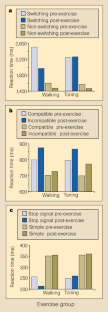Ageing, fitness and neurocognitive function (original) (raw)
- Scientific Correspondence
- Published: 29 July 1999
- Sowon Hahn1,
- Neal J. Cohen1,
- Marie T. Banich1,
- Edward McAuley1,
- Catherine R. Harrison1,
- Julie Chason1,
- Eli Vakil2,
- Lynn Bardell1,
- Richard A. Boileau1 &
- …
- Angela Colcombe1
Nature volume 400, pages 418–419 (1999)Cite this article
- 6954 Accesses
- 1174 Citations
- 125 Altmetric
- Metrics details
A Correction to this article was published on 16 December 1999
Abstract
In the ageing process, neural areas1,2 and cognitive processes3,4 do not degrade uniformly. Executive control processes and the prefrontal and frontal brain regions that support them show large and disproportionate changes with age. Studies of adult animals indicate that metabolic5 and neurochemical6 functions improve with aerobic fitness. We therefore investigated whether greater aerobic fitness in adults would result in selective improvements in executive control processes, such as planning, scheduling, inhibition and working memory. Over a period of six months, we studied 124 previously sedentary adults, 60 to 75 years old, who were randomly assigned to either aerobic (walking) or anaerobic (stretching and toning) exercise. We found that those who received aerobic training showed substantial improvements in performance on tasks requiring executive control compared with anaerobically trained subjects.
This is a preview of subscription content, access via your institution
Access options
Subscribe to this journal
Receive 51 print issues and online access
$199.00 per year
only $3.90 per issue
Buy this article
- Purchase on SpringerLink
- Instant access to full article PDF
Prices may be subject to local taxes which are calculated during checkout
Additional access options:
Figure 1: Tasks predicted to show selective improvements in performance for the walking but not for the toning group.

References
- Coffey, C. E. et al. Neurology 42, 527–536 (1992).
Google Scholar - Azari, N. P. et al. Brain Res. 552, 279–290 (1992).
Google Scholar - West, R. L. Psychol. Bull. 120, 272–290 (1996).
Google Scholar - Kramer, A. F., Larish, J. F., Weber, T. A. & Bardell, L. in Attention and Performance Vol. XVII (ed. Gopher, D. & Koriat, A.) (Academic, New York, 1999).
- Black, J. E., Isaacs, K. R., Anderson, B. J., Alcantara, A. A. & Greenough, W. T. Proc. Natl Acad. Sci. USA 87, 5568–5572 (1990).
Google Scholar - Neeper, S. A., Gomez-Pinilla, F., Choi, J. & Cotman, C. Nature 373, 109 (1995).
Google Scholar - Rogers, R. D. et al. Brain 121, 815–842 (1998).
Google Scholar - Rafal, R., Gershberg, F., Egly, R. & Ivry, R. Neuropsychologia 34, 1197–1202 (1996).
Google Scholar - Hanes, D. P., Patterson, W. F. & Schall, J. D. J. Neurophysiol. 79, 817–834 (1998).
Google Scholar - Dustman, R. E., Emmerson, R. & Shearer, D. J. Ageing Phys. Activ. 2, 143–181 (1994).
Google Scholar
Author information
Authors and Affiliations
- Beckman Institute, University of Illinois at Urbana-Champaign, 405 North Mathews Avenue, Urbana, 61801, Illinois, USA
Arthur F. Kramer, Sowon Hahn, Neal J. Cohen, Marie T. Banich, Edward McAuley, Catherine R. Harrison, Julie Chason, Lynn Bardell, Richard A. Boileau & Angela Colcombe - Department of Psychology, Bar-Ilan University, Ramat-Gan, Israel
Eli Vakil
Authors
- Arthur F. Kramer
- Sowon Hahn
- Neal J. Cohen
- Marie T. Banich
- Edward McAuley
- Catherine R. Harrison
- Julie Chason
- Eli Vakil
- Lynn Bardell
- Richard A. Boileau
- Angela Colcombe
Rights and permissions
About this article
Cite this article
Kramer, A., Hahn, S., Cohen, N. et al. Ageing, fitness and neurocognitive function.Nature 400, 418–419 (1999). https://doi.org/10.1038/22682
- Issue Date: 29 July 1999
- DOI: https://doi.org/10.1038/22682